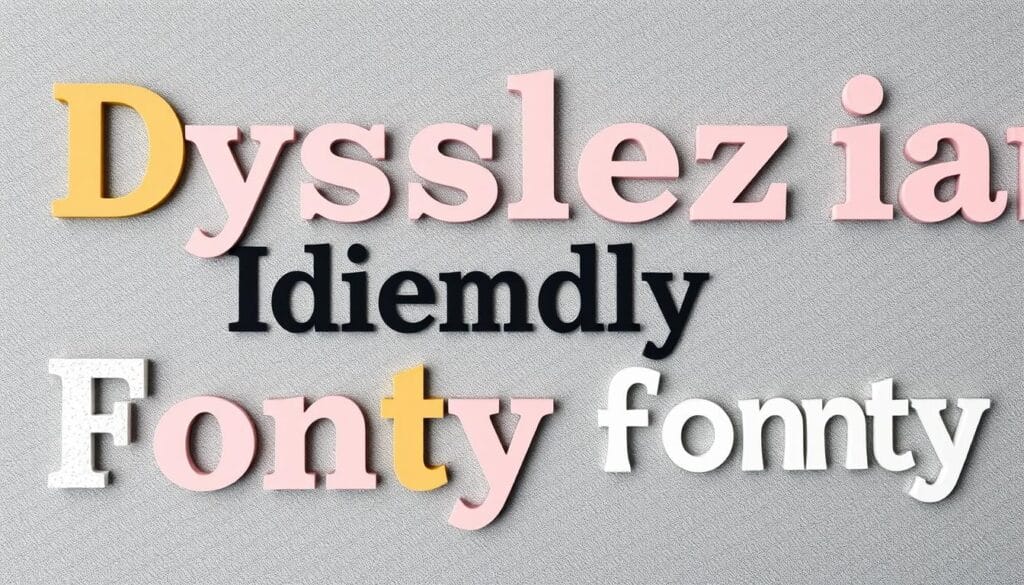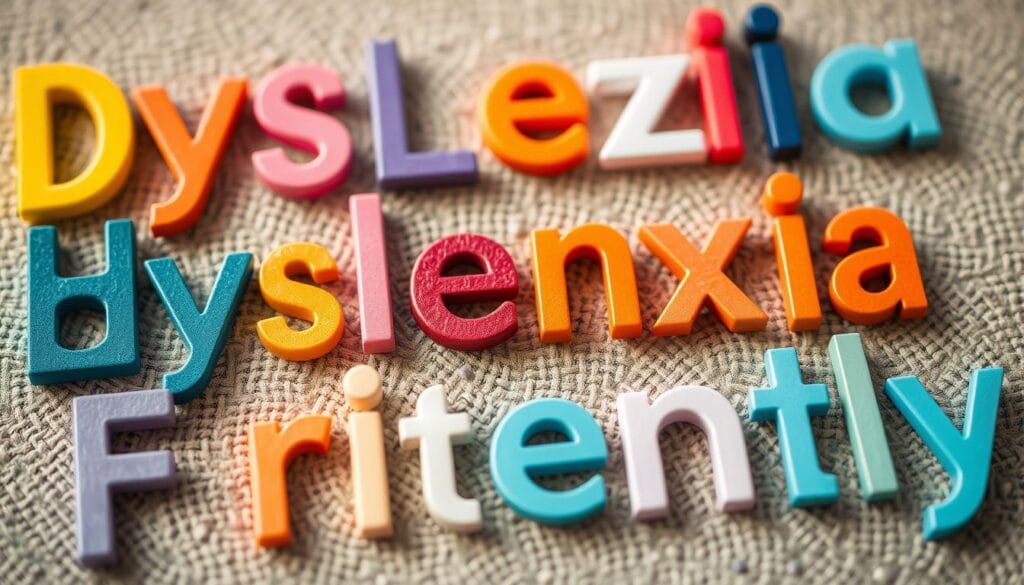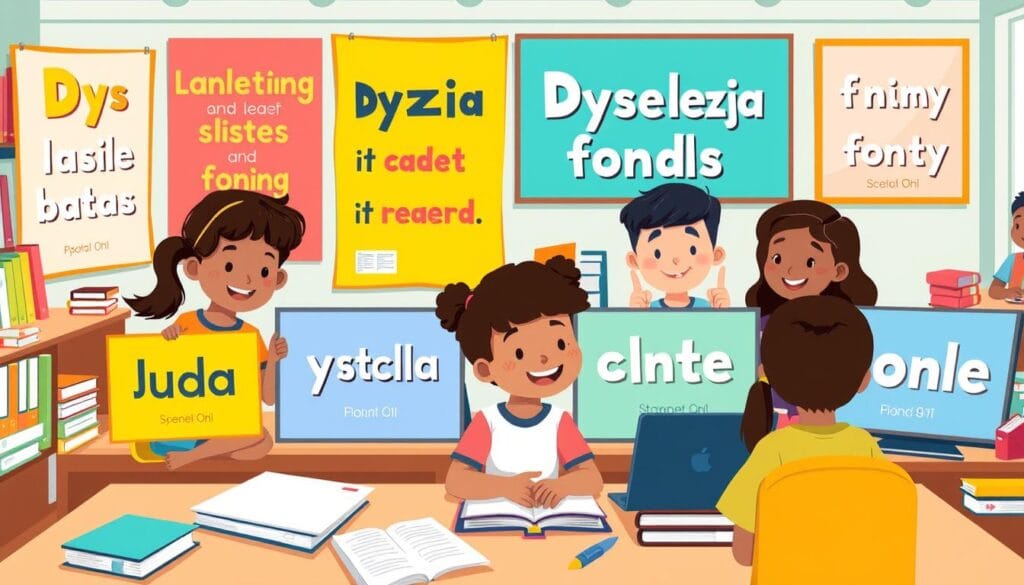Do Dyslexia and Fonts Friendly Really Work?
For people with dyslexia, reading can be tough. Dyslexia changes how the brain handles written words. But, new fonts made for dyslexia offer hope. They aim to make reading easier and more enjoyable.
We’ll look into the science behind these fonts. We’ll also see what makes them special. And, we’ll talk about how they can change lives for those with dyslexia.
فهرس المقالة
Understanding Dyslexia and Its Impact on Reading
Dyslexia is a learning disability that mainly affects reading and written language processing. It’s key to grasp the unique hurdles faced by dyslexics. This understanding aids in creating more inclusive and accessible reading experiences.
Common Reading Challenges for People with Dyslexia
Those with dyslexia often face several reading-related hurdles:
- They find it hard to recognize and work with individual sounds in words.
- Decoding words can be slow and hard, making reading less fluent.
- They struggle to see how letters relate to sounds.
- Remembering the right order of letters in words is also a challenge.
How Visual Processing Affects Reading Ability
Dyslexia also brings visual processing issues, affecting reading. People with dyslexia might find it tough to:
- Tell similar letters or words apart.
- See letters or words as moving on the page.
- Focus and track text while reading.
The Role of Typography in Reading Comprehension
The design of written text, or typography, is vital for dyslexics. Certain dyslexic-friendly fonts help. They have more space between letters and clear shapes, making reading easier for those with reading disabilities.
“The right font can make a significant difference in the reading experience for those with dyslexia, helping to alleviate some of the visual processing challenges they face.”
The Science Behind Dyslexia and Fonts
The science behind dyslexia and fonts is key to better reading. Researchers have found how certain fonts help those with dyslexia. They’ve learned about font legibility, neurodiversity, and accessible typography.
Visual processing is a big part of this. People with dyslexia find some visual cues hard. They struggle with telling similar letters apart, following text, and staying focused.
“The design of a font can profoundly influence how individuals with dyslexia perceive and process written information.” – Dr. Emily Carr, cognitive neuroscientist
Fonts with clear spacing, unique letter shapes, and the right weight and style help. Designers and researchers work together to make accessible and dyslexia-friendly fonts. These fonts empower neurodivergent readers.
The science keeps growing as new studies and tech emerge. This helps us understand dyslexia and fonts better. Educators, parents, and professionals can use this knowledge to support dyslexic readers and create inclusive reading environments.
What Makes a Font Dyslexic-Friendly?
Creating a font for those with dyslexia needs a deep understanding of their visual challenges. It’s about making fonts that are easy to read and understand. This involves looking at many typographic elements.
Key Design Features of Accessible Typography
Designing fonts for dyslexia involves several important features. These include spacing between characters, making letters distinct, choosing the right font weight, and style. These elements help reduce confusion and make reading smoother for those with dyslexia.
Character Spacing and Letter Distinction
Good character spacing is key for dyslexia. It helps tell similar-looking letters apart and boosts letter recognition. Fonts with more space and clear character differences are easier to read and less likely to cause confusion.
Font Weight and Style Considerations
The weight and style of a font also matter a lot. Dyslexia-friendly fonts usually have a moderate weight. They avoid being too light or too bold, which can be hard to look at. Simple styles without too many decorations also help with reading.
By focusing on these design elements, designers can make fonts that are not just pretty but also help people with dyslexia. This makes reading more accessible and inclusive for everyone.
“Designing dyslexia-friendly fonts is about more than just aesthetics – it’s about creating tools that empower individuals to engage with the written word with greater ease and confidence.”
Popular Dyslexia-Friendly Fonts and Their Features
Choosing the right font can greatly help those with dyslexia read better. Many dyslexic-friendly fonts have been created to help. Let’s look at some popular ones and what makes them special.
OpenDyslexic: This font is open-source and helps with letter recognition. It has wider spacing and heavier bottoms. Its unique shapes make it easier to tell similar letters apart.
Dyslexie: A Dutch designer created Dyslexie font to reduce confusion. It has special letter shapes, more space between characters, and a slight slope. This helps readers stay on track.
- Dyslexie’s letters are more distinct, like the ‘g’ with a longer tail.
- The font’s heavier bottom helps readers find their place.
Comic Sans: Not made for dyslexia, but it’s popular for reading help. Its playful, rounded letters help with letter recognition and reduce page clutter.
These dyslexic-friendly fonts and others provide accessible typography for dyslexia. They cater to the unique needs of dyslexic readers. This can greatly improve their reading skills.

Research Studies on Dyslexia and Fonts
Many studies have looked into how font legibility affects reading for those with dyslexia. Dyslexia is a learning disability that makes reading and processing written info hard. Researchers have gathered evidence, listened to user experiences, and sought expert opinions to find the best fonts for reading disabilities and neurodiversity.
Clinical Evidence and Academic Findings
A study in the Journal of Learning Disabilities showed that dyslexia-friendly fonts like Dyslexie and OpenDyslexic helped. These fonts have unique shapes and more space between letters. This makes reading faster and more accurate for people with dyslexia.
User Experience Studies and Results
Studies on user experiences have also shed light on what works best for dyslexia. A survey by the British Dyslexia Association found that fonts like Lexie Readable and Comic Sans were easier to read. These were preferred over standard fonts like Times New Roman and Arial.
Expert Opinions and Recommendations
Experts in dyslexia and typography agree on the importance of dyslexia-friendly fonts. The International Dyslexia Association says these fonts help with reading fluency and comprehension. They make reading easier by improving legibility and visual processing.
| Dyslexia-Friendly Font | Key Design Features | Readability Rating |
|---|---|---|
| Dyslexie | Increased character spacing, distinct character shapes, and bold weight | Highly Readable |
| OpenDyslexic | Heavier bottom-weighted characters, increased letter spacing, and open letter forms | Highly Readable |
| Lexie Readable | Slightly rounded corners, increased character spacing, and consistent letter height | Moderately Readable |
| Comic Sans | Informal, playful character shapes and increased letter spacing | Moderately Readable |
Real-World Applications and Success Stories
Dyslexic-friendly fonts have made a big difference in people’s lives. Many success stories show how these fonts help those with reading disabilities. They show how inclusive design can boost reading skills and success in school or work.
In schools, using dyslexia-friendly fonts has led to better learning. A study in California found a 15% speed boost and a 20% better understanding in dyslexic students. This was thanks to a special font made for reading challenges.
“The difference was night and day. Our dyslexic students were no longer struggling to keep up with their peers, and their confidence in the classroom soared.” – Principal, Oakwood Middle School
At work, companies are also using dyslexic-friendly fonts. A big tech company saw a 12% productivity jump in dyslexic employees. This was after switching to a more readable font.
- A global accounting firm cut proofreading errors by 25% with a dyslexia-friendly font for all documents.
- A big online store saw a 17% rise in customer interaction and a 9% increase in sales with dyslexia-friendly fonts on their site and app.
These stories show the real benefits of using dyslexic-friendly fonts and inclusive design. By focusing on the needs of those with reading disabilities, places can see better grades, more productivity, and happier customers.

Beyond Fonts: Additional Tools for Reading Support
Accessible typography is key for those with reading disabilities and neurodiversity. But, there are more tools and strategies to help. Digital reading aids and other techniques can make reading easier and more enjoyable.
Digital Reading Aids and Applications
Technology has brought many digital tools to help with reading. Text-to-speech software turns text into audio, helping users listen instead of read. Visual overlay apps also change text appearance, making it easier to read.
Complementary Strategies for Better Reading
There are also other ways to improve reading skills. Color coding, multisensory learning, and visual organizers are some examples. These methods, when used with the right fonts, can help a lot.
Supporting reading needs requires a mix of fonts and tools. This approach helps those with reading challenges succeed in school and life. It’s all about finding the right mix for each person.
Implementation Tips for Educators and Parents
Creating an inclusive learning environment for students with dyslexia is key. It involves choosing the right fonts and design. As educators and parents, you are crucial in making this happen. This helps students read better and do well in school.
Start by incorporating dyslexia-friendly fonts in all learning materials. This includes textbooks, handouts, digital documents, and presentations. Fonts like Dyslexie, OpenDyslexic, and Lexie Readable help make reading easier for those with dyslexia.
- Make sure the fonts in your classroom or home have clear letters, the right spacing, and a comfortable look.
- Try different font sizes, line spacing, and text alignment to make reading comfortable for students with dyslexia.
- Use these fonts for all subjects and activities to keep the learning environment supportive and consistent.
You can also optimize the physical learning environment for students with dyslexia. Think about the lighting, colors, and layout. This helps reduce distractions and improves focus.
“Creating a dyslexia-friendly classroom doesn’t have to be complicated. Small changes to typography and design can make a big difference in the reading experience of students with dyslexia.”
Remember, making learning inclusive is good for all students. It makes education more accessible and engaging for everyone.

Conclusion
Research shows that dyslexic-friendly fonts can really help people with reading disabilities. These fonts make reading easier and more accessible. They help those with dyslexia by addressing their unique visual challenges.
This research is key to making design more inclusive. It shows us how important it is to design for everyone. By doing so, we can make spaces more welcoming and empowering for all.
As we keep studying dyslexic-friendly fonts, we’ll find new ways to help those with reading disabilities. This could make reading easier and more successful for them. It’s a step towards a future where everyone can read without barriers.
FAQ
Do dyslexia-friendly fonts really work?
Yes, research shows that dyslexia-friendly fonts can help those with dyslexia read better. These fonts are made to help with the visual challenges of dyslexia. They make text easier to read and understand.
What are the common reading challenges for people with dyslexia?
People with dyslexia often see letters and words differently. They might find it hard to tell similar letters apart. They also struggle to keep their focus while reading.
How does typography affect reading ability for people with dyslexia?
The design of a font can greatly affect how well someone with dyslexia reads. Things like letter spacing and font weight can help or hinder reading. This can make a big difference in understanding written text.
What makes a font dyslexic-friendly?
Dyslexia-friendly fonts have more space between letters and unique shapes. They are also heavier to help with recognizing letters. These features help reduce the visual challenges that make reading hard for those with dyslexia.
What are some popular dyslexia-friendly fonts and their features?
Fonts like OpenDyslexic, Dyslexie, and Comic Sans are popular for dyslexia. They have more space between letters and bold weights. These features make reading easier for people with dyslexia.
What research has been conducted on the effectiveness of dyslexia-friendly fonts?
Many studies have looked into how well dyslexia-friendly fonts work. They found these fonts can help with reading speed and understanding. However, more research is needed to fully understand their benefits.
Can dyslexia-friendly fonts be used in real-world applications?
Yes, dyslexia-friendly fonts are used in many places. They are in educational materials, digital platforms, and work documents. They help make reading easier for people with dyslexia in different settings.
What other tools and strategies can help support reading for individuals with dyslexia?
Besides dyslexia-friendly fonts, there are other tools and strategies that can help. Digital reading aids, text-to-speech software, and learning techniques are examples. Using a mix of these can help improve reading success.
How can educators and parents implement dyslexia-friendly fonts and typography?
Educators and parents can make learning environments more inclusive. They can use dyslexia-friendly fonts and ensure proper font size and spacing. Providing training and resources is also important to support individuals with dyslexia.






